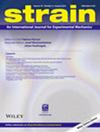Effect of fibre characteristics on physical, mechanical and microstructural properties of geopolymer concrete: A comparative experimental investigation
IF 1.8
3区 材料科学
Q2 MATERIALS SCIENCE, CHARACTERIZATION & TESTING
引用次数: 0
Abstract
The main aim of this work is to comparatively reveal the effect of fibre type, length and content on compressive strength and microstructure of structural geopolymer concrete (GPC) produced under constant mixture and curing parameters in order to address the significant gap in present literature. Firstly, GPCs with different NaOH concentrations (i.e., 6, 9, 12 and 15 M) and activator solution/binder (a/b) ratios (i.e., 0.45 and 0.55) were produced in ambient curing condition, and optimum production parameters were determined based on the preliminary evaluations. Then, glass and polypropylene fibres in 6‐mm length (GS6 and PP6) and polyamide and polypropylene fibres in 12‐mm length (PY12 and PP12) were included in GPCs at ratio of 0.4%, 0.8% and 1.2% (by volume). Compressive strength, apparent porosity, bulk density, ultrasonic pulse velocity (UPV), X‐ray diffraction (XRD) and scanning electron microscope (SEM) analysis of GPC samples were carried out comparatively. The inclusion of GS6 fibre enhanced the compressive strength thanks to fibre surface being covered by geopolymer gel and the strong adhesion between GS fibre and geopolymer matrix. SEM images of fibre reinforced GPC (FRGPC) also confirmed the experimental findings, which were attributed to improvement in compressive strength. Regardless of the fibre type, the maximum compressive value strength was obtained from GPC specimens with 0.4% fibre and then decreased. Higher fibre inclusions led to poor compaction, workability issues and inhomogeneous fibre dispersions. A very good relation (R2 = 0.98) was acquired between UPV and compressive strength values of GPC/FRGPC samples.纤维特性对地聚合物混凝土物理、力学和微观结构性能影响的对比试验研究
本工作的主要目的是比较揭示纤维类型、长度和含量对结构地聚合物混凝土(GPC)的抗压强度和微观结构的影响,以解决现有文献的重大空白。首先,在环境固化条件下制备了不同NaOH浓度(6、9、12和15 M)和活化剂/粘合剂(a/b)比(0.45和0.55)的GPCs,并在初步评价的基础上确定了最佳生产参数。然后,将长度为6 mm的玻璃纤维和聚丙烯纤维(GS6和PP6)以及长度为12 mm的聚酰胺纤维和聚丙烯纤维(PY12和PP12)以0.4%、0.8%和1.2%的比例(按体积计)加入GPCs中。对GPC样品的抗压强度、表观孔隙率、容重、超声脉冲速度(UPV)、X射线衍射(XRD)和扫描电镜(SEM)进行了比较分析。GS6纤维的加入,由于纤维表面被地聚合物凝胶覆盖,加之GS纤维与地聚合物基体具有较强的附着力,提高了抗压强度。纤维增强GPC (FRGPC)的SEM图像也证实了实验结果,这归因于抗压强度的提高。无论纤维类型如何,当纤维含量为0.4%时,GPC试件的抗压强度达到最大值,然后逐渐减小。较高的纤维内含物导致压实不良、可加工性问题和纤维分散性不均匀。UPV与GPC/FRGPC试样的抗压强度值之间存在很好的相关关系(R2 = 0.98)。
本文章由计算机程序翻译,如有差异,请以英文原文为准。
求助全文
约1分钟内获得全文
求助全文
来源期刊

Strain
工程技术-材料科学:表征与测试
CiteScore
4.10
自引率
4.80%
发文量
27
期刊介绍:
Strain is an international journal that contains contributions from leading-edge research on the measurement of the mechanical behaviour of structures and systems. Strain only accepts contributions with sufficient novelty in the design, implementation, and/or validation of experimental methodologies to characterize materials, structures, and systems; i.e. contributions that are limited to the application of established methodologies are outside of the scope of the journal. The journal includes papers from all engineering disciplines that deal with material behaviour and degradation under load, structural design and measurement techniques. Although the thrust of the journal is experimental, numerical simulations and validation are included in the coverage.
Strain welcomes papers that deal with novel work in the following areas:
experimental techniques
non-destructive evaluation techniques
numerical analysis, simulation and validation
residual stress measurement techniques
design of composite structures and components
impact behaviour of materials and structures
signal and image processing
transducer and sensor design
structural health monitoring
biomechanics
extreme environment
micro- and nano-scale testing method.
 求助内容:
求助内容: 应助结果提醒方式:
应助结果提醒方式:


